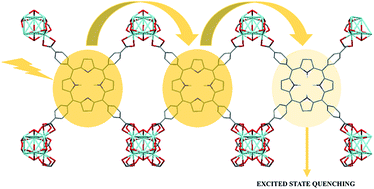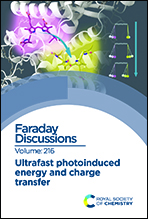Light harvesting and energy transfer in a porphyrin-based metal organic framework†
Abstract
We present the synthesis and photophysical characterization of a water stable PCN-223(freebase) metal organic framework (MOF) constructed from meso-tetrakis(4-carboxyphenyl)porphyrin (TCPP). The photophysical properties of the synthesized crystalline material were studied using a wide range of steady-state and time-resolved spectroscopic techniques. Quenching experiments performed on TCPP and PCN-223 demonstrated that the extent and the rate of quenching in the MOF is significantly higher than the monomeric ligand. Based on these results, we propose that upon photo-excitation, the singlet excitation energy migrates across neutral TCPP linkers until it is quenched by a N-protonated TCPP linker. The N-protonated linkers act as trap states that deactivate the excited state to the ground state. Variable temperature measurements aided in understanding the mechanism of singlet–singlet energy transfer in the PCN-223 MOF. The rate of energy transfer and the total exciton hopping distance in PCN-223 were calculated in order to quantify the energy transfer characteristics of PCN-223. Nanosecond transient absorption spectroscopy was used to study the triplet excited state photophysics in both the free ligand and PCN-223 MOF. Furthermore, femtosecond transient absorption spectroscopy was employed to get a better understanding of the photophysical processes taking place in the ligand and MOF on ultrafast timescales. Efficient energy transfer (Förster radius = 54.5 Å) accompanied with long distance exciton hopping (173 Å) was obtained for the PCN-223 MOF.

- This article is part of the themed collection: Ultrafast photoinduced energy and charge transfer


 Please wait while we load your content...
Please wait while we load your content...
